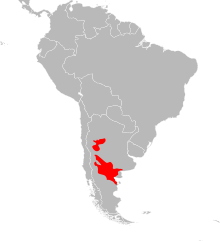| Liolaemus darwinii | |
|---|---|
| Scientific classification | |
| Domain: | Eukaryota |
| Kingdom: | Animalia |
| Phylum: | Chordata |
| Class: | Reptilia |
| Order: | Squamata |
| Suborder: | Iguania |
| Family: | Liolaemidae |
| Genus: | Liolaemus |
| Species: | L. darwinii
|
| Binomial name | |
| Liolaemus darwinii (Bell, 1843)
| |

| |
| Range map | |
| Synonyms[2] | |
Liolaemus darwinii, also known commonly as Darwin's tree iguana, is a species of lizard in the family Liolaemidae. The species is endemic to Argentina.
Etymology
[edit]The specific name, darwinii, is in honor of English naturalist Charles Darwin, the author of On the Origin of Species.[3]
Habitat
[edit]The preferred natural habitat of L. darwinii is shrubland, at altitudes from sea level to 3,000 m (9,800 ft).[1]
Description
[edit]The males of L. darwinii are brown with two yellow dorsal stripes that run along the spine, one on each side of the back.[citation needed] The females are solely brown.[citation needed]
Diet
[edit]L. darwinii eats various insects 5 cm (2.0 in) or less in length, including beetles and locusts.[citation needed]
Behavior
[edit]L. darwinii is diurnal.[citation needed] During nights and cold days, it burrows underground.[citation needed] It is a solitary and territorial.[citation needed] Males and females compete for territory.[citation needed]
Reproduction
[edit]L. darwinii is oviparous.[1][2] The mating season is in mid-February, and the nesting time is eight months later.[citation needed] The hatchlings are 5 cm (2.0 in) long, and clutch size is typically between 10 and 12.[citation needed]
References
[edit]- ^ a b c Pelegrin, N.; Avila, L. & Kacoliris, F. (2016). "Liolaemus darwinii ". The IUCN Red List of Threatened Species. 2016. IUCN: e.T56052691A56052804. doi:10.2305/IUCN.UK.2016-1.RLTS.T56052691A56052804.en. Retrieved 9 December 2017.
- ^ a b Species Liolaemus darwinii at The Reptile Database www.reptile-database.org.
- ^ Beolens, Bo; Watkins, Michael; Grayson, Michael (2011). The Eponym Dictionary of Reptiles. Baltimore: Johns Hopkins University Press. xiii + 296 pp. ISBN 978-1-4214-0135-5. (Liolaemus darwinii, p. 65).
Further reading
[edit]- Bell T (1843). The Zoology of H.M.S. Beagle, Under the Command of Captain Fitzroy, R.N., During the Years 1832 to 1836. London: Smith, Elder and Company. (Stewart and Murray, printers). vi + 51 pp. + Plates 1-20. (Proctotretus darwinii, new species, pp. 14–15 + Plate 7, Figures 1, 1a, 1b, 2, 2a).
- Boulenger GA (1885). Catalogue of the Lizards in the British Museum (Natural History). Second Edition. Volume II. Iguanidæ .... London: Trustees of the British Museum (Natural History). (Taylor and Francis, printers). xiii + 497 pp. + Plates I-XXIV. ("Liolæmus darwinii ", p. 155).
- Donoso-Barros, Roberto (1966). Reptiles de Chile. Santiago: Ediciones Universidad de Chile. 458 pp.
